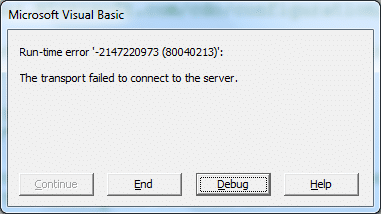
- #HTTP CLIENT TRANSPORT FAILURE UPDATE#
- #HTTP CLIENT TRANSPORT FAILURE CODE#
- #HTTP CLIENT TRANSPORT FAILURE PASSWORD#

Forwarding: the proxy makes the request for you, and sends back the response it obtained from the server.How exactly step 2/ is performed depends on which of two proxying mechanisms is used: The proxy transfers data to the server on your behalf.The client connects to the proxy (initial connection request).In general, the flow for making an HTTP request through a proxy is as follows: This section describes advanced proxy concepts and functionality.
#HTTP CLIENT TRANSPORT FAILURE PASSWORD#
When a request is made to a host that is found in the netrc file, the username and password will be included using HTTP basic auth. netrc config file allows authentication credentials to be associated with specified hosts.
#HTTP CLIENT TRANSPORT FAILURE UPDATE#
update ( download_task, completed = response. add_task ( "Download", total = total ) for chunk in response. TransferSpeedColumn (), ) as progress : download_task = progress. stream ( "GET", url ) as response : total = int ( response. NamedTemporaryFile () as download_file : url = "" with httpx. Import tempfile import httpx import rich.progress with tempfile. Once chardet is installed, we can configure a client to use character-set autodetection. Let's take a look at installing autodetection using one of these packages.
#HTTP CLIENT TRANSPORT FAILURE CODE#
chardet - This is a well established package, and is a port of the auto-detection code in Mozilla.There are two widely used Python packages which both handle this functionality: This callable should be a function which takes the input bytes as an argument and returns the character set to use for decoding those bytes to text. To use auto-detection you need to set the default_encoding argument to a callable instead of a string. In cases where the server is not reliably including character set information, and where we don't know what encoding is being used, we can enable auto-detection to make a best-guess attempt when decoding from bytes to text. text ) # The text will either be decoded with the Content-Type # charset, or using "shift-jis". encoding ) # This will either print the charset given in # the Content-Type charset, or else "shift-jis". Client ( default_encoding = "shift-jis" ) # Using the client. Import httpx # Instantiate a client with a Japanese character set as the default encoding.

This will ensure that connections are properly cleaned up when leaving the with block: The recommended way to use a Client is as a context manager. The other sections on this page go into further detail about what you can do with a Client instance. Applying configuration across all outgoing requests.Reduced latency across requests (no handshaking).Ĭlient instances also support features that aren't available at the top-level API, such as:.This can bring significant performance improvements compared to using the top-level API, including: This means that when you make several requests to the same host, the Client will reuse the underlying TCP connection, instead of recreating one for every single request. On the other hand, a Client instance uses HTTP connection pooling. As the number of requests to a host increases, this quickly becomes inefficient. When you make requests using the top-level API as documented in the Quickstart guide, HTTPX has to establish a new connection for every single request (connections are not reused). More efficient usage of network resources If you do anything more than experimentation, one-off scripts, or prototypes, then you should use a Client instance.

More efficient usage of network resourcesĬharacter set encodings and auto-detection


 0 kommentar(er)
0 kommentar(er)
